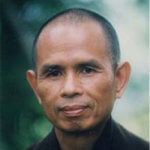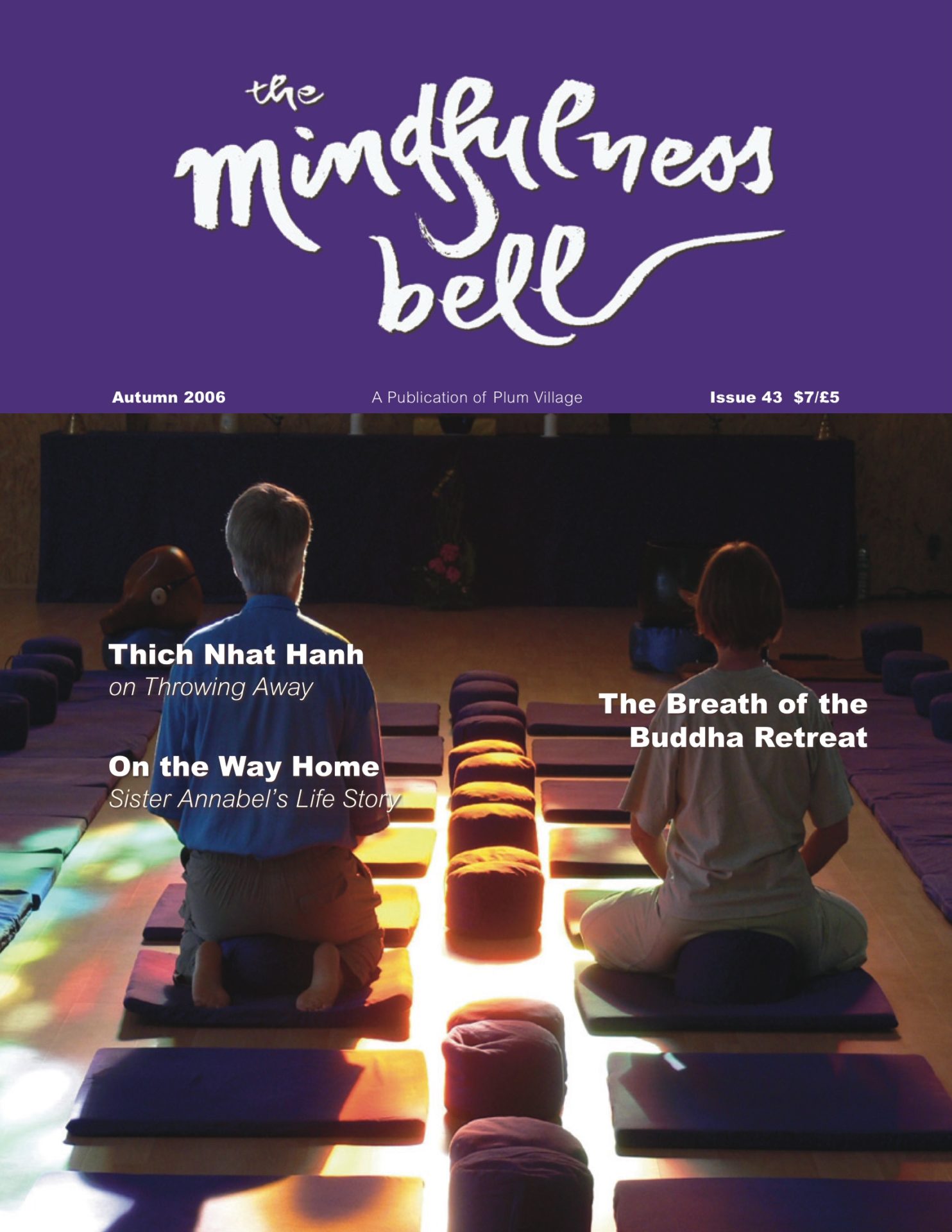By Thich Nhat Hanh in October 2006
June 7 – 8, 2006
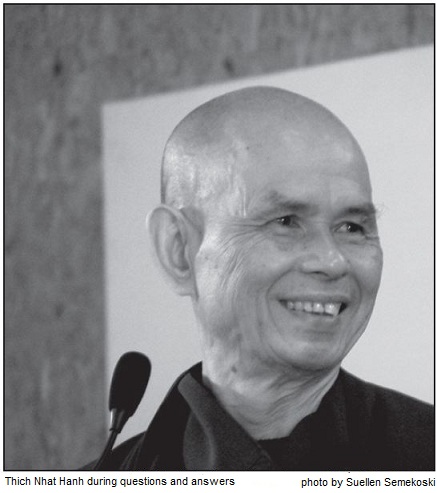
During the Breath of the Buddha retreat at Plum Village, Thây focused on the Sutra on Mindful Breathing, which he had just translated from the Chinese. In this excerpt from two Dharma talks,Thây discusses exercises 11 through 14.
Exercise 11: Skillfully he practices breathing in,
By Thich Nhat Hanh in October 2006
June 7 – 8, 2006

During the Breath of the Buddha retreat at Plum Village, Thây focused on the Sutra on Mindful Breathing, which he had just translated from the Chinese. In this excerpt from two Dharma talks,Thây discusses exercises 11 through 14.
Exercise 11: Skillfully he practices breathing in, concentrating his mind. Skillfully he practices breathing out, concentrating his mind.
Exercise 12: Skillfully he practices breathing in, liberating his mind. Skillfully he practices breathing out, liberating his mind.
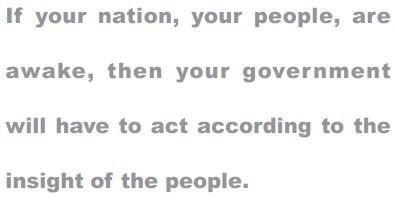
The practice of concentration helps us to understand the nature of affliction, and with that kind of insight, we can burn affliction away. Concentration as energy has the power of transformation. Concentration is something extremely important in the teaching of the Buddha.
To concentrate means to concentrate on something. In the teaching of the Buddha, many kinds of concentration are proposed. According to our need, we can apply one or two of these concentrations to free us, like concentration on impermanence, concentration on non-self, concentration on compassion, concentration on interbeing, and so on. Each concentration, each samadhi, has its own name.
The Buddha spoke about the three doors of liberation, which are considered to be three concentrations: emptiness, signlessness, and aimlessness.
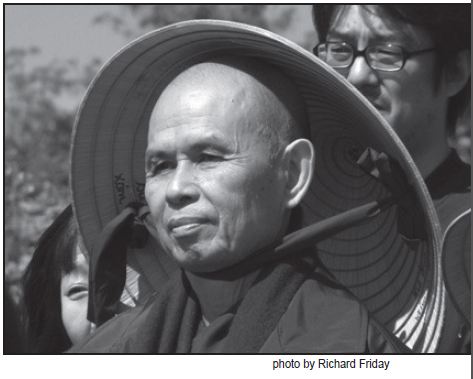
Emptiness is not a philosophy, a description of reality. Emptiness is a practice. Emptiness does not mean non-being, non-existence. There’s a big difference between non-existence and emptiness. Suppose we look at the glass. It is empty. The glass is empty, but the glass is not non-existent, right? In order to be empty, you have to be there. That is one thing you can learn—emptiness is not non-existence. The second thing is that when we say the glass is empty, you have to ask, “Empty of what?” It’s not empty of air. It is empty of tea, but it is full of air. So the intelligent question to ask is, “Empty of what?” The first answer may be: empty of a separate existence, empty of a separate self.
This is the simplest description in the Buddhist scriptures about emptiness, about interbeing: this is, because that is. As practitioners, we don’t just speak of emptiness as a teaching philosophy. We have to transform emptiness into a complete practice.
Signlessness is the second door of liberation. “Sign” means the appearance or the form. We are used to seeing the form that is the object of our perception. Nimita is the form. Animita is formlessness, or signlessness. The practice is not to be attached to the form, and this needs some training.
Those of us who have lost a loved one, we know grief. But if you are equipped with the concentration of signlessness, formlessness, you can overcome your grief, your sorrow, very quickly. You are capable of seeing things in the light of signlessness: nothing is born, nothing dies. Everything continues in this new form. You also! Your nature is the nature of deathlessness.
Aimlessness is the third door of liberation. Apranihita is the Sanskrit term. Apranihita means you don’t put anything in front of you as object of your pursuit. What you are looking for is already there, not outside of you. You are already what you want to become. You are wonderful just like that. Don’t try to be something else, someone else. You don’t have to go to the future in order to get what you want. Everything you are looking for, it is right here, in the here and the now, including the Kingdom of God, your immortality, your deathlessness. Your enlightenment is right here. And that is truly the third door of liberation: aimlessness.
The Concentration on Loving Kindness
There is a concentration called maitri, karuna—love, compassion. And the contemplation on love, on compassion, can bring you a lot of relief, can bring the nectar of healing to you.
Suppose someone has made you suffer. You think of him or her as very cruel. That person has inflicted on you a lot of suffering, on your family, on your country. And because of that you want that person or that group of persons to suffer a lot for you to get relief. You are thinking in terms of punishment. That hate, that anger, that will to revenge is a kind of fire that continues to burn your body and your mind, and you are in hell. Hell is here in the here and the now.
Just before, we spoke about the Kingdom of God being in the here and the now. But that is true of hell. Hell can be in the here and the now. If we allow the flame of affliction to burn us, there are moments when lying on our bed we cannot sleep because our whole body, our whole being is burned by the fire of hate, of anger, of despair.
The concentration on maitri, on karuna, on compassion, will help you to suffer less.
With your attention focused on the other person, you can see that the other person suffers a lot also. The fact is that when someone suffers a lot and is not capable of handling his or her own suffering, she will spill her suffering all over, and you become a victim of that.
And you may be like that. You are suffering a lot, and if you don’t know how to manage your suffering, you continue to suffer and you will make others around you suffer, including the people you love.
Looking deeply, we see that the other person, as a child, did not have a chance to learn love and compassion from his or her parents. The parents have caused a lot of wounds in him, in her, as a child; and no one has helped him or her to heal the wounds in the child. And then when they went to school, the teacher did not help, and the students around did not help. The seeds of anger, suffering, and hate continued to grow.
Such a person needs help, not punishment. By looking deeply and recognizing the presence of suffering in that person, you might see the truth that that person needs help. And now if we punish him, he will suffer more.
This insight may motivate you to do something to help that person. With that kind of insight, the hate and anger vanish, because that insight brings the nectar of compassion. And the nectar of compassion is wonderful. You stop suffering right away. The fire that has been burning, stops burning. That is the effect of metta meditation, the meditation on compassion.
Compassion for a Suicide Bomber
Nowadays we learn that there are many young people in the Mideast, they are ready to die, to blow themselves up with a bomb in order to kill as many as possible. We call them terrorists, and we believe that in order for the world to be peaceful, you have to kill all these terrorists. So you invest a lot of money and energy into what you call the war against terror. The more you kill, the more terrorists you create, because the killing is an act of punishment. Then the family and the friends of the one who is killed burn with the flame of anger, the will to punish. In killing one so-called terrorist, you create three, four terrorists more. That is what is happening.
There are many young people who suffer so much hate and despair, not only in Iraq, but also in Europe, in America. The number of young people who kill themselves every day is enormous. When you are burned by the flame of despair, of hate, of violence, you suffer so much. And as a young person, you don’t know much about your mind, about the practice. You believe that the only way to stop the suffering, the burning, is to kill yourself.
I guess for many young people, to die is much easier than to live, because they are overwhelmed by the emotions—of hate, of despair. And then you are told that by dying you might help the cause of justice, and you can go to paradise right away after death.
These kinds of perceptions and feelings lead to the act of suicide bombing. If you look deeply, you see that these people need help. And the operation to kill them is not the right answer. We have to help them to see there is a way out of suffering, that only love and compassion and understanding can solve the problem.
One side is using violence. The other side is responding with violence. And the situation goes on without a chance to stop. The way out is shown by the Buddha. Hate cannot respond to hate. Violence cannot respond to violence. There must be another way. The meditation on compassion is essential.
During the war in Vietnam we were able—myself and many friends of ours—to see that the young Americans who came to Vietnam to kill or to be killed were also victims of a wrong policy. With that kind of insight we tried to work for reconciliation rather than supporting one side of the war.
In my experience, the concentration on compassion is a wonderful practice. You may need only fifteen minutes of breathing deeply and looking deeply to recognize that the other person is a victim of his or her own suffering. That person needs you, needs your help, and does not need your punishment. Suddenly the nectar of compassion is born, your heart is blessed with that nectar, and you don’t suffer any more. Instead, you want to do something, to say something, and if you are not capable of loving speech you can write a letter. You can say something kind in order to help that person. But you cannot help that person until you have been able to help yourself. Peace and compassion always begin with yourself.
The Reality of Impermanence
Exercise 13: Contemplating impermanence, I breathe in. Contemplating impermanence, I breathe out.
Impermanence is a key that can unlock the door of reality. It is also a concentration, a practice. Intellectually we know that things are impermanent. We can agree with the truth of impermanence. Our scientists also agree that things are impermanent. But in reality we still behave as though things are permanent.
We have to keep the insight of impermanence alive. When we come in touch with anything, we should be able to see the nature of impermanence in it.
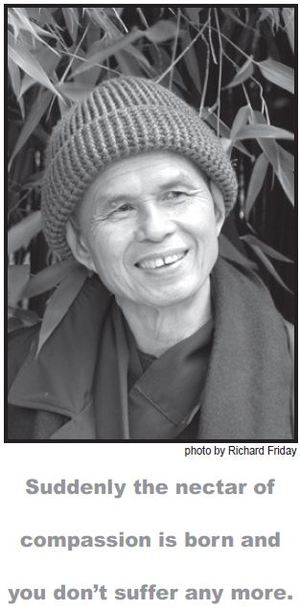
We have to distinguish between the notion of impermanence and the insight of impermanence. We may have the notion of impermanence, we may have understood what impermanence is, but we do not have the insight of impermanence. The insight is something alive.
Impermanence is a fact that science has to recognize. When you are able to see the nature of impermanence, you’ll begin to see the nature of non-self. Because non-self is not different from impermanence. Since everything is changing in every second, nothing can remain itself in two consecutive moments. So impermanence means non-self. They are the same thing.
Looking from the angle of time, you say, impermanence. Looking from the angle of space, you say, non-self. They are exactly the same thing.
In the Pali canon, non-desire comes next. In the Chinese canon, throwing away is next.
Throwing Away What?
Exercise 14: Skillfully, he practices breathing in, contemplating letting go. Skillfully, he practices breathing out, contemplating letting go.
Throwing away is a wonderful practice. You might like to ask, “Throwing away what?” What is to be thrown away?
We have learned that wrong perceptions are the ground of all afflictions— fear, anger, discrimination, despair. So it’s easy to know that throwing away here means to throw away wrong perceptions—ideas or notions—that are at the base of our suffering. It is the most important practice in Buddhist meditation. You have an idea, and you entertain that idea for a long time, and you continue to suffer.
Every one of us entertains an idea about happiness. It may be because of that idea of happiness that we’ve never been happy. So it’s very important to throw away that notion of happiness.
A nation is a community of people, and they may entertain together one idea, one ideology. Each political party—the socialist party, for instance—entertains an idea. And we might get caught in that idea. An ideology may be a trap, and your nation may be caught in it for sixty, seventy years, and during that time you create a lot of suffering. Those who do not agree with that ideology, you put them in psychiatric hospitals. The moment you release that idea, happiness begins to be possible.
So throwing away is very important. It takes insight and courage in order to throw away an idea.
The word is “throwing away.” It’s very strong; it’s not just letting go. The Sanskrit, the Pali term, is “throwing away” in a very strong way. The Vietnamese meditation master Tang Hoi, he used the word phong xa for throwing away. Tang Hoi was the first teacher of meditation in Vietnam, who lived in the first half of the third century.
Insights from the Diamond Sutra
The Diamond Sutra advises us to throw away four notions. The first notion is the notion of self. It is by intensive training that you can throw away the notion of self.
If a couple knows how to live in a spirit of non-self, there will be no difficulty, no anger, no discrimination, no despair, because they have realized the truth of non-self. If a father and son, mother and daughter, have the insight of non-self, they look at each other as interbeing.

There is the idea that I am this body. This body is mine, belongs to me. This is a notion that does not correspond to reality. When we say the words “I am,” we say it on the ground of the notion “I am,” and still people do not believe very much in that statement. That is why they try to justify it with a kind of argument.
In order to demonstrate that “I am” is a reality, René Descartes said, “I think, therefore I am.” One day I saw a cartoon picturing Descartes touching a horse. He declared, “I think, therefore I am.” And the horse asked back, “You are what?” That is a good question. If you can answer what you are, you may have a better idea that is closer to reality.
In the scripture it is written, “This is, because that is.” This is a statement about interbeing. If you are not there, I cannot be here.
So it is very important to throw away the notion “I am,” the notion of self, because it does not reflect the truth. By looking deeply into the nature of reality, you are capable of throwing away that notion of “I am.”
The second notion that the Diamond Sutra advises us to throw away is the notion “man,” human being. This is not too difficult. When we look into the human being, we see human ancestors, we see animal ancestors, we see vegetable ancestors, we see mineral ancestors. We see that the human is made of non-human elements. We see that we are at the same time a rock, a river, a cloud, a squirrel, a rose. And if we take away all the non-human elements, the human being is no longer there.
This is the deepest teaching on deep ecology. In order to protect the human being, you have to protect elements that are not human, because these elements are our ancestors, and if you destroy them there is no way we can be here. That is why discrimination between man and nature is a wrong view. You have to see you as nature, one with nature.
That is why harmony, respect of life, is possible. So throw away the idea that the human being is the boss, man is the boss, man can do anything to nature. The key is contemplation on impermanence of non-self.
The first to be thrown away is the notion of self, the second is the notion of man. With liberation from that notion, we become less proud, less arrogant as a species. We have to respect and protect other species in order for us to have a chance. That is why we said the Diamond Sutra is the oldest text on deep ecology.
We have the notion of la matiere inerte. But if you look deeply into the notion that matter is something without soul, without life, we see that is not true.
First of all, matter is the object of our perceptions. For a long time we believed that matter exists as a separate entity, and matter is something that does not move. But now as science advances, we see that matter is not static and immobile as we thought. In fact, the atoms, the electrons, move a lot. They are very alive. And looking more deeply, we see a lot of our mind in it, and we are not sure that they are there, in the way we imagined. So the distinction between living beings and non-living beings disappears after meditation. There is no longer any discrimination.
The fourth notion to be thrown away is the notion of lifespan. We believe that there is time, and we are born at one point of time. Our birth begins here, and we shall die at another point of time—death. I’ll only spend seventy, eighty, ninety or one hundred years on this planet. After that, I’ll be gone. This is what we believe. But as we look deeply, we see that this is a notion, a wrong perception. Birth is a notion, and death is also a notion. It’s not reality.
We have spoken of the deathlessness of a cloud. The cloud can never die. It can only become rain or snow. In our mind, to die means from something you become nothing; from someone you become no one. But if you look deeply you don’t see anything like that. A cloud can never die. If we look deeply we see that the nature of the cloud is also the nature of no birth. In our mind, to be born means from nothing we become something. From no one we suddenly become someone.
The cloud does not come from nothing. It has come from the water in the river, in the ocean. It has come from the sunshine, the heat. And you know that the birth of a cloud is a poetic image. It is a new manifestation. Before being a cloud, the cloud has been many other things.
Our true nature is the nature of no birth and no death. Birth and death are notions that cannot be applied to reality, because nothing can be born from nothing, and nothing can become nothing at all. This meditation practice of looking deeply will bring about insight. It will dissipate our fear and our despair.
Those are the four basic notions that are at the foundation of our fear, our desperation, our suffering. That is why the Diamond Sutra advises us to practice looking deeply, so that we can throw them away. The practice of throwing away your notions, your views, is so important. Emancipation and liberation would not be possible without this practice of throwing away.
If we suffer a lot, it’s because we still entertain a number of ideas. The practice of meditation helps us to get free from these ideas.
Our World Needs Wisdom
So the object of our meditation is not something alien to our daily life. The way proposed by the Buddha is to help yourself and to help the people around you. It is to practice looking more deeply in order to be liberated from these notions that are at the foundation of hate, fear, and violence.
Writing a letter to a suicide bomber is true meditation. Meditation is not an escape. It is the courage to look at reality with mindfulness and concentration. Our world needs wisdom and insight. As a teacher, as a parent, a journalist, a filmmaker, you are capable of sharing your insight so that you can wake up your nation, your people. And if your nation, your people, are awake, then your government will have to act according to the insight of the people.
Meditation is essential for our survival, our peace, our protection. In fact, it is wrong views that are at the base of our suffering, and throwing away wrong views is the most important, most urgent thing.
To come to a retreat is not to get away from it all. To come to a retreat is an opportunity to look deeper, and to see exactly where we are.
Transcribed by Greg Sever.Edited by Greg Sever and Janelle Combelic.
The Sutra on Mindful Breathing
This is what I have heard at a time when the Buddha was residing in the Jeta Grove in the town of Sravasti.
On that day, the World-Honored One told the Bhikshus:
“Dear friends, let us enjoy the practice of Mindful Breathing. If a Bhikshu knows how to skillfully practice Mindful Breathing, and does so consistently, he will find his body and mind peaceful; he will acquire positive investigations and reflections; his mind will be calm and pure; and he will have perceptions leading to Wisdom and be able to bring his practice to completion.
“This is how a bhikshu should proceed:
“Whether the bhikshu lives in a village or in a town, in the morning he puts on his sanghati, holds his begging bowl, and goes into town for alms round. While doing so, he knows how to protect his body and his six senses, his mind skillfully focused on whatever is present. After the alms round, he returns to his dwelling, puts his sanghati and begging bowl away, washes his feet, goes into the forest, to an empty room, to the foot of a tree, or to an empty space in the open air, and sits down in an upright position. He holds his mindfulness in front of him, releases all worldly pursuits, and lets go of his anger, torpor, restlessness, regret and doubt, his mind determined to be in accord with wholesome dharmas, leaving far behind the five hindrances that cause afflictions, weaken his wisdom and constitute an obstacle on the path of Nirvana.
1. “Skillfully, he practices breathing in, fully aware of his in-breath. Skillfully, he practices breathing out, fully aware of his out-breath.
2. “Skillfully, he practices breathing in a long or a short in-breath, fully aware of his long or short in-breath. Skillfully, he practices breathing out a long or a short out-breath, fully aware of his long or short out-breath.
3. “Skillfully, he practices breathing in, fully aware of his whole body. Skillfully, he practices breathing out, fully aware of his whole body.
4. “Skillfully, he practices breathing in, relaxing his whole body. Skillfully, he practices breathing out, relaxing his whole body.
5. “Skillfully, he practices breathing in, experiencing joy. Skillfully, he practices breathing out, experiencing joy.
6. “Skillfully, he practices breathing in, experiencing happiness. Skillfully, he practices breathing out, experiencing happiness.
7. “Skillfully, he practices breathing in, aware of his feelings. Skillfully, he practices breathing out, aware of his feelings.
8. “Skillfully, he practices breathing in, calming his feelings. Skillfully, he practices breathing out, calming his feelings.
9. “Skillfully, he practices breathing in, aware of his mind. Skillfully, he practices breathing out, aware of his mind.
10. “Skillfully, he practices breathing in, gladdening his mind. Skillfully, he practices breathing out, gladdening his mind.
11. “Skillfully, he practices breathing in, concentrating his mind. Skillfully, he practices breathing out, concentrating his mind.
12. “Skillfully, he practices breathing in, liberating his mind. Skillfully, he practices breathing out, liberating his mind.
13. “Skillfully, he practices breathing in, contemplating impermanence. Skillfully, he practices breathing out, contemplating impermanence.
14. “Skillfully, he practices breathing in, contemplating letting go. Skillfully, he practices breathing out, contemplating letting go.
15. “Skillfully, he practices breathing in, contemplating non-desire. Skillfully, he practices breathing out, contemplating non-desire.
16. “Skillfully, he practices breathing in, contemplating cessation. Skillfully, he practices breathing out, contemplating cessation.
“Bhikshus! That is how the practice of Mindful Breathing helps make our body and mind peaceful, helps us acquire positive investigations and reflections, makes our mind calm and pure, helps us have perceptions leading to Wisdom, and brings our practice to completion.”
After the Buddha had finished his teaching, the bhikshus, having listened to the Buddha, happily put the teachings into practice.
Taisho Tripitaka Vol. 2, No. 99, Tsa A Han (No. 29) 803.Chinese translated from Sanskrit by Gunabhadra, A.D. 435-443 (Liu Song period). Translated from Chinese by Thich Nhat Hanh.
